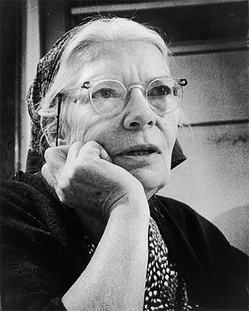 I don't hide the fact that I believe Dorothy Day is a very reasonable and attractive candidate for the Church to canonize. Following John Paul's insistence, we need more contemporary saints from among the laity. Several times in the past years I have posted articles on Dorothy Day (+1980) and I am happy to do so again today. My enthusiasm has less to do with Day's social activism --even though at one time the Catholic Worker Houses were more Catholic and Benedictine-like-- as it does with her accepting the truth of Jesus Christ as Messiah, her eventual conversion to Catholicism and her being a Benedictine Oblate.
I don't hide the fact that I believe Dorothy Day is a very reasonable and attractive candidate for the Church to canonize. Following John Paul's insistence, we need more contemporary saints from among the laity. Several times in the past years I have posted articles on Dorothy Day (+1980) and I am happy to do so again today. My enthusiasm has less to do with Day's social activism --even though at one time the Catholic Worker Houses were more Catholic and Benedictine-like-- as it does with her accepting the truth of Jesus Christ as Messiah, her eventual conversion to Catholicism and her being a Benedictine Oblate.Recently in Benedictine Oblate Category
 I don't hide the fact that I believe Dorothy Day is a very reasonable and attractive candidate for the Church to canonize. Following John Paul's insistence, we need more contemporary saints from among the laity. Several times in the past years I have posted articles on Dorothy Day (+1980) and I am happy to do so again today. My enthusiasm has less to do with Day's social activism --even though at one time the Catholic Worker Houses were more Catholic and Benedictine-like-- as it does with her accepting the truth of Jesus Christ as Messiah, her eventual conversion to Catholicism and her being a Benedictine Oblate.
I don't hide the fact that I believe Dorothy Day is a very reasonable and attractive candidate for the Church to canonize. Following John Paul's insistence, we need more contemporary saints from among the laity. Several times in the past years I have posted articles on Dorothy Day (+1980) and I am happy to do so again today. My enthusiasm has less to do with Day's social activism --even though at one time the Catholic Worker Houses were more Catholic and Benedictine-like-- as it does with her accepting the truth of Jesus Christ as Messiah, her eventual conversion to Catholicism and her being a Benedictine Oblate.
O God, Who in Saint Frances of Rome, has given us a model of holiness in married life and of monastic conversion, make us serve You perseveringly, so that in all circumstances we may set our gaze upon You and follow You.
This painting given here for today's lectio is attributed to Antonio del Massaro da Viterbo, depicts Saint Frances of Rome (1384-1440) being clothed by the Mary in the white veil of her Benedictine movement that, even today, characterizes the Olivetan Benedictine Oblates of Mary she founded in 1425.
Mary, Mother of God wears a mantle of gold, which Saint Paul at the left wraps around Frances Romana. The presence of certain saints is instructive: the great evangelizer, Saint Paul, Saint Mary Magdalene (the Apostle to the Apostles and dressed in red) and Saint Benedict, the Father of Western Monastic Life, with the various ranks of angels, including Francesca's Guardian Angel. Magdalene and Benedict wrap/invest the mantle on the gathered Oblates.
The angel below the Gothic windows is busy carding golden threads with a warp and loom. Nearby are two frisky dogs and two cats, a frequent sight in Rome. The Oblate Congregation, commonly thought to be woven together by heavenly graces and harassed by evil spirits. The evil one is given flesh in the form of cats and dogs. As a testimony of grace the Oblates flourish today at Tor de'Specchi. Several years ago I had the privilege with many others to pray in this monastery opened to the public only Saint Frances' feast day.
I have longed hoped that the Oblates of Saint Frances of Rome would found a house in the USA. We are ready for this witness.
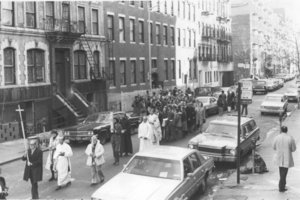 Today is the 32nd anniversary of death of the Servant of God Dorothy Day. The Benedictine Oblate from Brooklyn Heights, NY, who is remembered for her conversion to Christ and His Church and with Peter Maurin founded The Catholic Worker Movement.
Today is the 32nd anniversary of death of the Servant of God Dorothy Day. The Benedictine Oblate from Brooklyn Heights, NY, who is remembered for her conversion to Christ and His Church and with Peter Maurin founded The Catholic Worker Movement.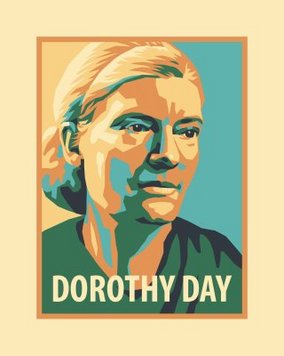 There are some among the Christian faithful who would prefer not to spend resources, personal and financial, on the sainthood investigation of the Servant of God Dorothy Day. As we know the US bishops have recently given their approval for the process to move forward. The for Day's cause for canonization is being promoted by the Archdiocese of New York; Cardinal Timothy Dolan is a very strong supporter, as is Cardinal Francis George among others.
There are some among the Christian faithful who would prefer not to spend resources, personal and financial, on the sainthood investigation of the Servant of God Dorothy Day. As we know the US bishops have recently given their approval for the process to move forward. The for Day's cause for canonization is being promoted by the Archdiocese of New York; Cardinal Timothy Dolan is a very strong supporter, as is Cardinal Francis George among others. 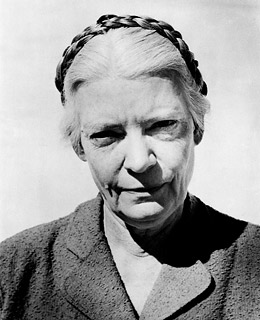 The canonization process of the Servant of God Dorothy
Day (1897-1980) the US Conference of Catholic Bishops (USCCB) by an unanimous voice vote on
November 13, 2012 at the annual meeting of the bishops.
The canonization process of the Servant of God Dorothy
Day (1897-1980) the US Conference of Catholic Bishops (USCCB) by an unanimous voice vote on
November 13, 2012 at the annual meeting of the bishops. The feast of King Saint Henry (972-1024) always brings with it a keen remembrance of the commitment one makes as an Benedictine Oblate: seeking God unreservedly. The offering of oneself to God as a Benedictine oblate is a singular grace to take the gift of one's humanity seriously as God has given it with the express desire to totally adore Him who makes us.
The feast of King Saint Henry (972-1024) always brings with it a keen remembrance of the commitment one makes as an Benedictine Oblate: seeking God unreservedly. The offering of oneself to God as a Benedictine oblate is a singular grace to take the gift of one's humanity seriously as God has given it with the express desire to totally adore Him who makes us. As we Venerate the glorious memory of the most holy Virgin Mary, grant, we pray, O Lord, through her intercession, that we, too, may merit to receive from the fullness of your grace.
As we Venerate the glorious memory of the most holy Virgin Mary, grant, we pray, O Lord, through her intercession, that we, too, may merit to receive from the fullness of your grace.This weekend is the 71 st annual retreat of the New York area Benedictine Oblates of the Archabbey of Saint Meinrad. The retreat is being held at Mariandale Retreat House, Ossining, NY with the retreat master being Brother John Mark Falkenheim, OSB. His theme is "Grace and Human Nature in the Rule of Saint Benedict."
Pray for the 35 Oblates.

 The Church recalls the witness of an emperor and a Benedictine Oblate, Saint Henry (972-1024), Duke of Bavaria. Henry was crowned king in Rome by Pope Benedict VIII in 1014. It is said that Henry was assisted by the saints throughout his life but especially at Mass when he was anointed king. He was an insightful leader, lay man who had concern for the discipline of the Church and who had love for the Benedictine monastic life. He was a supporter of Cluny's reforms. It was through Saint Henry that the King of Hungary and later saint, Stephen, met Christ and was baptized.
The Church recalls the witness of an emperor and a Benedictine Oblate, Saint Henry (972-1024), Duke of Bavaria. Henry was crowned king in Rome by Pope Benedict VIII in 1014. It is said that Henry was assisted by the saints throughout his life but especially at Mass when he was anointed king. He was an insightful leader, lay man who had concern for the discipline of the Church and who had love for the Benedictine monastic life. He was a supporter of Cluny's reforms. It was through Saint Henry that the King of Hungary and later saint, Stephen, met Christ and was baptized.
An Oblate of Saint Benedict is a Christian individual (lay people and diocesan priests) who is associated with a particular
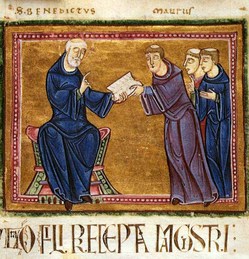 Benedictine monastery, usually one that is close to where one lives, in order to enrich his or her Christian way of life. An Oblate forms and sustains a spiritual bond with the monastery where the oblation is made. So, the hope is that those making an oblation actually share in a spiritual union that is based in friendship with a particular monastic community. Bonded in prayer, love and commitment, Oblates are partners in the prayer and works of the monastery and with the professed monks, nuns and oblates search for God together with the goal of arriving at our destiny: the Beatific Vision, God.
Benedictine monastery, usually one that is close to where one lives, in order to enrich his or her Christian way of life. An Oblate forms and sustains a spiritual bond with the monastery where the oblation is made. So, the hope is that those making an oblation actually share in a spiritual union that is based in friendship with a particular monastic community. Bonded in prayer, love and commitment, Oblates are partners in the prayer and works of the monastery and with the professed monks, nuns and oblates search for God together with the goal of arriving at our destiny: the Beatific Vision, God.
Oblates are most often Catholics, but practicing members of the Christian ecclesial communities are also welcome to be Oblates. But for Catholic Oblates, there is a crucial connection between the Holy Eucharist and sacred Scripture, devotion to the Blessed Virgin Mary and faithfulness to the Church teaching. The hope is that an Oblate conforms his or her life according the Gospel, the Rule of Saint Benedict and the constitutions (customs) of a particular family of monks or nuns, e.g., the American-Cassinese Congregation, the Swiss-American Congregation or the English Benedictine Congregation or whatever monastic family in which you make your oblation. An example could be that as monks take a new name upon entering the monastic life so too do some Oblates take on an "oblate name" signalling a change of heart and mind. This name is not for legal use, mind you.
Some simple duties of a Benedictine Oblate are:
-daily praying of Lauds and Vespers (doing the other Hours are encouraged)
-daily Lectio Divina
-daily reading of a chapter of the Rule of Saint Benedict (no more than 3-4 paragraphs)
-frequent reception of the sacraments of Holy Communion and Confession
-keep some portion of the day in silence as possible
-be committed to ongoing spiritual, intellectual and human formation
-if possible, see a spiritual director
-keep an awareness of the Trinitarian life in front of you, that in all things God may be glorified
-keep the bond of friendship with the monastery of oblation as possible
-and perhaps doing some charitable work as possible.
As a Christian the Oblate seeks God by striving to become a saint in his or her daily life; this is accomplished by integrating a life of prayer and work because they manifest Christ's presence to society.
Available websites:
General Information on Benedictine Oblates
International Benedictine Oblates
The Oblate Forum
The Oblate Newsletter from
The Oblate Newsletter from
A good example of Oblate Statutes comes from the Monastery of Jesus Crucified (Branford, CT). The former chaplain wrote the statutes with the sisters.
Saint Benedict and Saint Scholastica, pray for us!
Saint Maurus and Saint Placid, pray for us!
Saint Henry and Saint Frances of Rome, pray for us!
 O Glorious St. Benedict, sublime model of all virtues, pure vessel of God's grace! Behold me, humbly kneeling at thy feet. I implore thy loving heart to pray for me before the throne of God. To thee I have recourse in all the dangers which daily surround me. Shield me against my enemies, inspire me to imitate thee in all things. May thy blessings be with me always, so that I may shun whatever God forbids and avoid the occasions of sin.
O Glorious St. Benedict, sublime model of all virtues, pure vessel of God's grace! Behold me, humbly kneeling at thy feet. I implore thy loving heart to pray for me before the throne of God. To thee I have recourse in all the dangers which daily surround me. Shield me against my enemies, inspire me to imitate thee in all things. May thy blessings be with me always, so that I may shun whatever God forbids and avoid the occasions of sin.Graciously obtain for me from God those favors and graces of which I stand so much in need, in the trials, miseries and afflictions of life. Thy heart was always so full of love, compassion, and mercy towards those who were afflicted or troubled in any way. Thou didst never dismiss without consolation and assistance anyone who had recourse to thee. I therefore invoke thy powerful intercession in the confident hope that thou will hear my prayers and obtain for me the special grace and favor I so earnestly implore (mention it), if it be for the greater glory of God and the welfare of my soul.





